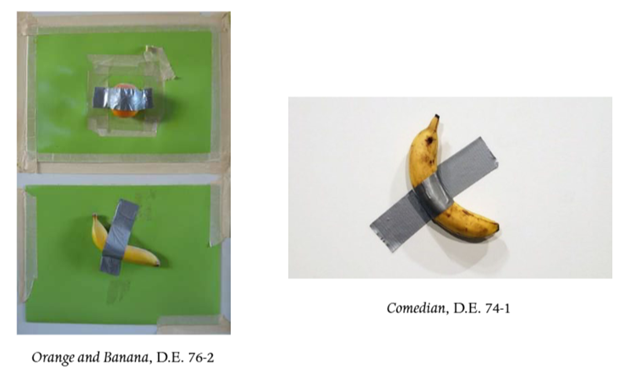In an unpublished opinion, the US Court of Appeals for the Eleventh Circuit affirmed a district court’s decision finding that a pro se Californian artist failed to establish that an Italian artist had reasonable opportunity to access the copyrighted work simply because it was available to view on the internet. Morford v. Cattelan, Case No. 23-12263 (11th Cir. Aug. 16, 2024) (Jordan, Pryor, Branch, JJ.) (per curiam).
A plaintiff alleging copyright infringement may show factual copying by either direct or indirect evidence showing “that the defendant had access to the copyrighted work and that there are probative similarities between the allegedly infringing work and the copyrighted work.” To do so, however, the copyright owner must establish a nexus between the work and the defendant’s alleged infringement. Mere access to a work disseminated in places or settings where the defendant may have come across it is not sufficient.
Joe Morford’s Banana and Orange and Maurizio Cattelan’s Comedian both “involve the application of duct tape to a banana against a flat surface” (see images below from the court decision’s appendix). Cattelan’s Comedian went viral and sold for more than $100,000 at Miami’s Art Basel. Morford claimed that Comedian was a copy. The district court found that Morford failed to show that Cattelan had reasonable opportunity to access Banana and Orange and thus could not establish a copyright claim. Morford appealed.

On appeal, Morford argued that because he could show striking similarity between Banana and Orange and Comedian, he was not required to proffer evidence of access to show copyright infringement. In the alternative, he argued that he could show substantial similarity and that Cattelan had reasonable opportunity to access Banana and Orange as it was widely disseminated and readily discoverable online.
The Eleventh Circuit explained that in circuits adopting a widespread dissemination standard, that standard requires showing that the work enjoyed “considerable success or publicity.” Morford showed that Banana and Orange was available on his public Facebook page for almost 10 years and featured on his YouTube channel and in a blog post, with views in more than 25 countries. But Banana and Orange’s availability on the internet, without more, was “too speculative to find a nexus” between Cattelan and Morford to satisfy the factual copying prong of a copyright infringement claim, according to the Court.
The Eleventh Circuit also found that Morford failed to meet the high burden of demonstrating that the original work and accused infringement were so strikingly similar as to establish copying. Such similarity exists if the similarity in appearance between the two works “is so great that [it] precludes the possibility of coincidence, independent creation or common source,” but identical expression does not necessarily constitute infringement. In this analysis, a court addresses the “uniqueness or complexity of the protected work as it bears on the likelihood of copying.” Morford argued that he [...]
Continue Reading
read more

 Subscribe
Subscribe


